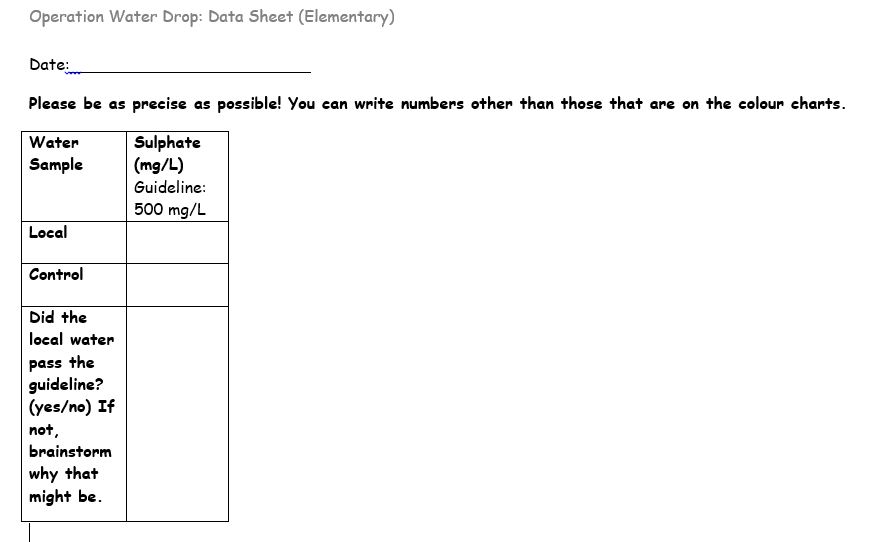Purpose: To determine if the water sample meets Canadian Drinking Water Guideline for Sulphate making a visual comparison of precipitate present. Testing will be done on Local community treated water; the teacher will do this as a demonstration. There is a 500 mg/L Canadian Drinking Water Guideline for sulphate in drinking water; you will test and compare your result to see if it meets these guidelines.
Materials:
• 3 - Plastic cups
• 2 – 2 mL plastic pipettes
• 1 – 2 mL Canadian Guideline for Sulphate sample (CGLS) (500 mg/L CAD)
• 3 – 5 mL vial containing 2 mL of Sulphate Reagent 1
• 3 – 5 mL vial containing 3 mL of Sulphate Reagent 2
• 50 mL graduated cylinder (not supplied with kit – teacher must supply)
Method:
Label the 3 plastic cups with appropriate number, and name:
#1 - Control
#2 - Canadian Guideline (CGLS)
#3 - Local Community Treated WaterLabel the 2 pipettes: DI (for Deionized Water), LTW (for Local Community Treated Water).
Using a graduated cylinder, measure out 25mL of Deionized Water to each of the 3 cups.
To the #1 Control cup, add 2ml of the Deionized Water using the pipette labeled DI.
To the #1 Control cup, add contents of one of the Sulphate Reagent 1 tubes.
To the #1 Control cup while swirling, add contents of one of the Sulphate Reagent 2 tubes. Continue swirling for 1 minute and then set the cup aside.
To the #2 cup (Canadian Guideline (CGLS)), add contents of tube labeled Canadian Guideline (CGLS).
To the #2 cup, add contents of one of the Sulphate Reagent 1 tubes.
To the #2 cup while swirling, add contents of one of the Sulphate Reagent 2 tubes. Continue swirling for 1 minute and then set the cup aside.
To the #3 cup, using the pipette labeled LTW, add 2 mL of the Local Community Treated Water.
To the #3 cup, add contents of the Sulphate Reagent 1 tube.
To the #3 cup while swirling, add contents of the Sulphate Reagent 2 tube. Continue swirling for 1 minute and then set the cup aside.
Determine the cloudiness of the cups Relative to the Canadian Guideline for Sulphate sample (CGLS) (more or less cloudy) and record the results.
Record Your Results
Results:
The Canadian Guideline sample should be cloudy. The local community treated water sample may or may not be cloudy. If the water sample is less cloudy than the Canadian Guideline, then it passes the Canadian Drinking Water Guideline for Sulphate, which is 500 mg/L. The Control should not have any cloudiness present.
Safe Handling of Materials
Caution must be taken at all times when handling any chemicals. Although this test is safe to use in any area, please be cautious with the materials supplied.
Visit the Safe Drinking Water Foundation Website www.safewater.org to learn more about issues affecting safe drinking water.


